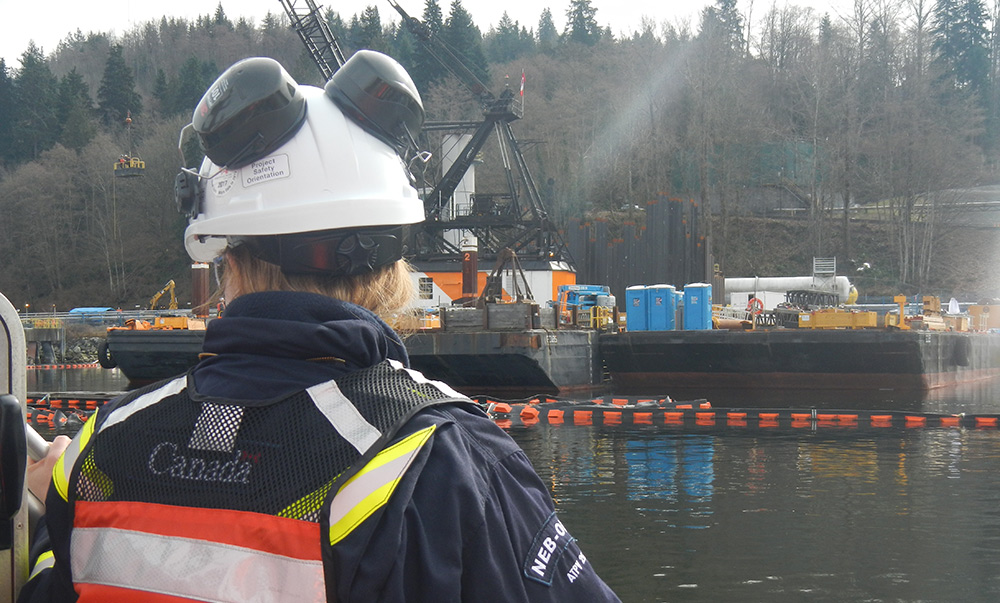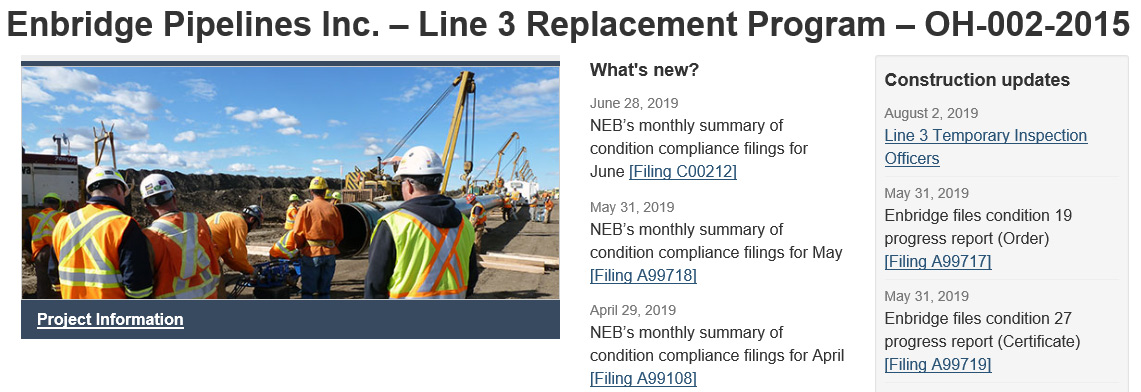Safety and Environment Oversight
The NEB sets and enforces regulatory expectations for National Energy Board-regulated companies over the full lifecycle–construction, operation and abandonment– of energy-related activities.
The NEB’s expectations of regulated companies are set out in the acts and regulations relevant to the Boards mandate, as well as through Board directions and orders. Companies must fulfil any commitments they make in their submissions to the NEB, throughout all phases of regulatory oversight.
The NEB holds its regulated companies accountable against these expectations using a rigorous compliance verification and enforcement program, and through enforcement actions. We require regulated companies to anticipate, manage, and mitigate any potential threats to safety and the environment that may occur through the full lifecycle of their facilities.
Our Commitment
Harm to people or the environment, through the lifecycle of energy-related infrastructure, is prevented.
Safety and Environment Oversight Activity in 2018-19:
-
 374
374
Compliance Verification Activities Including: -
 145
145
Inspections -
 20
20
Emergency Exercises -
 7
7
Management System Audits -

2
Financial System Audits
Performance Results – Safety and Environment Oversight
Number of incidents related to National Energy Board–regulated infrastructure that harm people or the environment.
- Target 0
- Results
2017-18* 19 - Results
2018-19 25
Percentage change of specific incident types on National Energy Board–regulated infrastructure.**
- Target -10% decrease in incidents
- Results
2017-18 +13% increase - Results
2018-19 +2% increase
Percentage change of near-misses on National Energy Board–regulated infrastructure.***
- Target -5%
- Results
2017-18 +15% - Results
2018-19 -9%
* REVISED FROM ANNUAL REPORT 2017-18. AS A PART OF ROUTINE REPORTING AND ASSESSMENT PROCEDURES, QUARTERLY AND ANNUAL NUMBERS CAN VARY SLIGHTLY AS COMPANIES OR NEB STAFF ENTER DATA INTO THE SYSTEM.
** % INCREASE OR DECREASE OF INCIDENTS THAT HARM PEOPLE OR THE ENVIRONMENT FOR THE 3 YEAR AVERAGE NUMBER OF INCIDENTS CALCULATED LAST YEAR COMPARED TO THE 3 YEAR AVERAGE NUMBER OF INCIDENTS CALCULATED THIS YEAR.
*** %INCREASE OR DECREASE OF UNAUTHORIZED ACTIVITIES FROM THE PREVIOUS YEAR.
THREE-TIERED APPROACH
The NEB takes a three–tiered approach to preventing incidents that harm people and the environment:
- Activity–based: risk informed compliance verification activities
- Systemic: management system improvement to control risks and hazards
- Cultural: influencing Safety Culture and the human factors that are foundational to reducing incidents

The NEB always aims to achieve zero incidents that harm people or the environment on the 73,000 km that we regulate. The NEB takes every incident very seriously.
And, when activities pose greater harm to people or the environment, we focus attention and increased regulatory oversight through inspections, investigations and audits. Where non-compliances are observed through compliance verification activities (CVAs), the NEB uses enforcement actions to achieve company compliance as quickly and as effectively as possible. This reduces hazards and protects the safety of workers, the public, the environment and property.
The NEB has seen an increase in the number of incidents that harm people and the environment with the total numbers rising from 19 in 2017–18 to 25 in 2018–19. The biggest proportion of the 25 incidents that harm were a total of 12 serious injuries, mainly to construction workers. Similarly, the biggest increase year–over–year was also in serious construction worker injuries, which went from 7 to 12.
The NEB reviews every serious incident and identifies root causes. The learnings inform our inspections and our oversight programs. As a result of reviews of these serious injuries the NEB has increased our oversight of constructions projects and in particular third party contractors.
The NEB tracks and takes action on all incidents and uses incident data as a part of our risk model to plan compliance activities. Incidents are reported publically on our website.
Under Construction: Worker Safety
The NEB has identified that the majority of serious injury incidents involve third-party contractors. To that end, the NEB conducted pre-construction audits, such as our audit in advance of the Keystone XL Pipeline construction, with a focus on contractor oversight. The NEB undertook compliance and enforcement activities related to serious injuries in addition to following up on every incident. This included inspectors visiting the field to observe firsthand how the companies conduct incident response. Over 2018–19, the NEB conducted 23 field inspections directly related to worker safety, including eight on Enbridge Line 3.
The NEB also has a Serious Injury and Fatality Team that is convened when any serious injury is reported to the NEB. This team consists of a number of safety experts who assess the incident to determine whether the NEB needs to take any immediate actions. We are also reaching out to other industries and regulators to share learnings and approaches that can help reduce serious injuries to workers.
NEB regulatory actions are management system– focused and are informed by results of incident root cause, trending and analysis of pipeline performance information, leading indicators, research, technology and industry best practices.
Audit Information Advisories: Increased Communication, Increased Transparency
The NEB has heard from companies that they do not always understand how to interpret some regulatory requirements. In addition, because NEB audits are typically not done on the same company each year, it’s not obvious to the broader regulated industry what the NEB is finding year–over–year. The NEB is committed to making changes to communicate more effectively with companies and the public.
The NEB has issued information advisories over the past three years that outline key gaps and findings from our management system audits. The goal of these advisories is to:
- leverage lessons learned;
- provide clarity regarding the NEB’s expectations, to guide consistent interpretation of regulations going forward; and,
- bring attention to some commonly noted management system gaps.
Sharing NEB’s audit information broadly allows companies to get a better understanding of findings and, as a result, understand NEB regulations and expectations better.
This will in turn decrease the potential for harms to occur. The NEB intends to revisit the audit findings we communicate to companies and measure whether they are repeated, not just among the audited organizations, but among all companies.

Safety Culture: Listening, Leveraging and Learning from Each Other
The NEB hosted a Safety Culture Workshop in February 2019 at the NEB office in Calgary, Alberta. This initiative brought together 14 representatives from eight NEB regulated companies and a number of NEB technical staff and executives to have an open dialogue on safety culture advancement efforts, challenges and best practices. The workshop facilitated meaningful conversation among the participants and encouraged sharing of experiences and learning from one another in a small group environment.
Safety culture means “the attitudes, values, norms and beliefs, which a particular group of people shares with respect to risk and safety”.
The workshop objectives were to promote learning and sharing across NEB regulated companies and between the NEB and regulated companies to improve our collective performance. Participants noted that evaluating and monitoring contractor and sub–contractor safety culture is a challenge associated with broader industry safety culture advancement. Other industries and jurisdictions have identified similar issues and developed related strategies and recommendations, including:
- Focusing on long-term relationships with suppliers in order to enhance collaboration and knowledge sharing (e.g., facilitating two–way learning and feedback loops);
- Pre-qualification of contractors based upon indicators that capture the organization’s ability to prevent, predict and manage risk (e.g., status of implementing improvement plans, results of audit programs, management involvement and the quality of how near misses, incidents and risk assessment processes are managed and related issues resolved); and
- Performing extensive planning and analysis during the contracting process (e.g., early engagement of contractors in the planning process) in order to understand how contractual conditions may affect risk-sharing between operator and contractor.
Workshop attendees discussed the relevance of these findings to the oil and gas sector and offered insights about alternative approaches that are currently being employed and lessons learned.
Damage Prevention: Reducing Potential for Harm
Unauthorized activities (UAs) or “Near misses” are a leading indicator of areas and activities where harm could occur, and tracking them provides the NEB with additional insight on areas of greater risk so that we can take targeted action.
Over 2018–19, the number of UAs reported dropped by just over 16%, from 276 to 231. Assessing each reported UA, and in particular ground disturbances, provides the NEB with valuable information on how to further support safe digging practices.
Education and awareness remain the best defense against unauthorized activities, and the NEB’s Damage Prevention team drove improvements in reporting results through focused engagement with stakeholders and industry, including:
- Undertaking focused engagement with two large organizations that reported repeat ground disturbance UAs. This led them to make significant changes to their planning and ground disturbance processes, and neither has had a UA since;
- Developing damage prevention guidance for municipalities with the Lower Mainland Municipalities, through collaboration with the NEB’s Vancouver Regional Office, and with the Canadian Energy Pipeline Association (CEPA) Damage Prevention Work Group;
- Providing subject matter expertise and support on two Canadian Standards Association (CSA) technical committees, including CSA Z663 Land Use Planning in the Vicinity of Pipelines Standard, published in December 2018, and CSA Z247 (2015) Damage Prevention Standard; and,
- Implementing a Damage to Pipe report, which closed a reporting gap on certain types of damages caused by company contractors, damages resulting from authorized activities, and damages that previously had not met the reporting threshold. This has enabled better visibility into where and how UAs are occurring.
Managing Emergencies
Pipeline ruptures are rare. On average there have been 0.02 ruptures per 1,000 km of NEB regulated pipeline over the past five years. Of these, five out of a total of six ruptures reported to the NEB were natural gas or natural gas liquids. In all cases, the NEB’s Emergency Management program stands ready to take quick action by deploying staff or standing up its Emergency Operations Centre (EOC).
In October 2018, a natural gas pipeline operated by Enbridge Pipelines ruptured just outside of Prince George, BC. No injuries were reported, and community members from the nearby Lheidli T’enneh First Nation were evacuated as a precaution.
The NEB has an established Memorandum of Understanding with the BC Oil and Gas Commission (BCOGC). This allowed BCOGC field staff to represent the NEB at the company’s Incident Command Post (ICP) prior to the deployed NEB field staff arriving on site, enabling a faster, more efficient initial response. In the meantime, the NEB activated its EOC in Calgary. Field staff were deployed to the site to attend the company’s ICP in Prince George and inspect the site once it was safe to access.
Engagement Specialists were also deployed to Prince George to liaise with the affected First Nations communities and other stakeholders. NEB inspectors issued an Inspection Officer Order (IOO) that required that the company meet specific measures before restarting the line or any adjacent lines.
During these types of events, the NEB shares jurisdiction with the Transportation Safety Board (TSB). The TSB has the jurisdiction to determine the root cause and contributing factors. The NEB is participating in this investigation and will take actions to ensure the ongoing protection of the public and the environment.
Guidelines for Pipeline Financial Requirements: Driving Company Accountability
The Canadian Environmental Protection Act, 1999 sets out several guiding principles including “polluter pays”, which protects the public from paying for clean–up of any potential pipeline spill. The NEB enforces the polluter pays principle, requiring all necessary measures to be taken to make the pipeline safe, clean up the spill and remediate the environment, regardless of whether a company is found to be at fault or not.
The Pipeline Safety Act of 2016 amended the NEB Act by introducing a $1 billion absolute liability level to pipeline companies with the capacity to transport greater than 250,000 barrels of oil per day, and requiring such companies to maintain the financial resources equal to their absolute liability level.
In June 2018, the Pipeline Financial Requirements Regulations were passed. These regulations set out absolute liability limits for all other NEB regulated pipeline companies. The regulations came into force in 2019, and going forward all NEB–regulated pipeline companies must maintain financial resources equal to their respective absolute liability limits, or a greater amount if determined by the NEB.
To support this, the NEB developed guidance outlining what companies should demonstrate for meeting the financial resource requirements in the NEB Act and the regulations, as well as a schedule for companies to submit Financial Resource Plans. The draft guidance was provided for both regulated company and public comment in February and March 2019. The input received enabled the NEB to provide greater clarity in the guidance, which was subsequently released at the end of March 2019.


